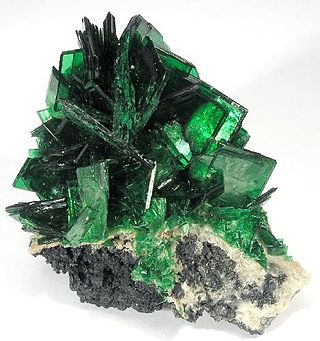
Torbernite, also known as chalcolite, is a relatively common mineral with the chemical formula Cu[(UO2)(PO4)]2(H2O)12. It is a radioactive, hydrated green copper uranyl phosphate, found in granites and other uranium-bearing deposits as a secondary mineral. The chemical formula of torbernite is similar to that of autunite in which a Cu2+ cation replaces a Ca2+ cation. Torbernite tends to dehydrate to metatorbernite with the sum formula Cu[(UO2)(PO4)]2(H2O)8.
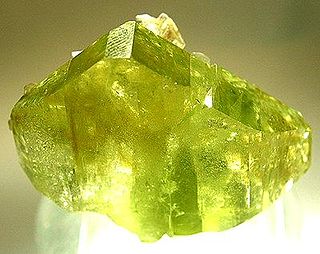
Brazilianite, whose name derives from its country of origin, Brazil, is a typically yellow-green phosphate mineral, most commonly found in phosphate-rich pegmatites.

Olivenite is a copper arsenate mineral, formula Cu2AsO4OH. It crystallizes in the monoclinic system (pseudo-orthorhombic), and is sometimes found in small brilliant crystals of simple prismatic habit terminated by domal faces. More commonly, it occurs as globular aggregates of acicular crystals, these fibrous forms often having a velvety luster; sometimes it is lamellar in structure, or soft and earthy.
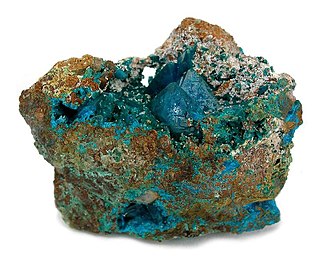
Liroconite is a complex mineral: Hydrated copper aluminium arsenate hydroxide, with the formula Cu2Al[(OH)4|AsO4]·4(H2O). It is a vitreous monoclinic mineral, colored bright blue to green, often associated with malachite, azurite, olivenite, and clinoclase. It is quite soft, with a Mohs hardness of 2 - 2.5, and has a specific gravity of 2.9 - 3.0.

Vauxite is a phosphate mineral with the chemical formula Fe2+Al2(PO4)2(OH)2·6(H2O). It belongs to the laueite – paravauxite group, paravauxite subgroup, although Mindat puts it as a member of the vantasselite Al4(PO4)3(OH)3·9H2O group. There is no similarity in structure between vauxite and paravauxite Fe2+Al2(PO4)2(OH)2·8H2O or metavauxite Fe3+Al2(PO4)2(OH)2·8H2O, even though they are closely similar chemically and all minerals occur together as secondary minerals. Vauxite was named in 1922 for George Vaux Junior (1863–1927), an American attorney and mineral collector.

Fornacite is a rare lead, copper chromate arsenate hydroxide mineral with the formula: Pb2Cu(CrO4)(AsO4)(OH). It forms a series with the phosphate mineral vauquelinite. It forms variably green to yellow, translucent to transparent crystals in the monoclinic - prismatic crystal system. It has a Mohs hardness of 2.3 and a specific gravity of 6.27.

Duftite is a relatively common arsenate mineral with the formula CuPb(AsO4)(OH), related to conichalcite. It is green and often forms botryoidal aggregates. It is a member of the adelite-descloizite Group, Conichalcite-Duftite Series. Duftite and conichalcite specimens from Tsumeb are commonly zoned in color and composition. Microprobe analyses and X-ray powder-diffraction studies indicate extensive substitution of Zn for Cu, and Ca for Pb in the duftite structure. This indicates a solid solution among conichalcite, CaCu(AsO4 )(OH), austinite, CaZn(AsO4)(OH) and duftite PbCu(AsO4)(OH), all of them belonging to the adelite group of arsenates. It was named after Mining Councilor G Duft, Director of the Otavi Mine and Railroad Company, Tsumeb, Namibia. The type locality is the Tsumeb Mine, Tsumeb, Otjikoto Region, Namibia.
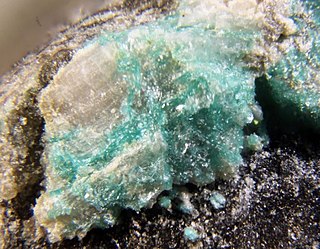
Campigliaite is a copper and manganese sulfate mineral with a chemical formula of Cu4Mn(SO4)2(OH)6·4H2O. It has a chemical formula and also a crystal structure similar to niedermayrite, with Cd(II) cation replacing by Mn(II). The formation of campigliaite is related to the oxidation of sulfide minerals to form sulfate solutions with ilvaite associated with the presence of manganese. Campigliaite is a rare secondary mineral formed when metallic sulfide skarn deposits are oxidized. While there are several related associations, there is no abundant source for this mineral due to its rare process of formation. Based on its crystallographic data and chemical formula, campigliaite is placed in the devillite group and considered the manganese analogue of devillite. Campigliaite belongs to the copper oxysalt minerals as well followed by the subgroup M=M-T sheets. The infinite sheet structures that campigliaite has are characterized by strongly bonded polyhedral sheets, which are linked in the third dimension by weaker hydrogen bonds.

Plumbogummite is a rare secondary lead phosphate mineral, belonging to the alunite supergroup of minerals, crandallite subgroup. Some other members of this subgroup are:

Lavendulan is an uncommon copper arsenate mineral, known for its characteristic intense electric blue colour. It belongs to the lavendulan group, which has four members:

Cornubite is a rare secondary copper arsenate mineral with formula: Cu5(AsO4)2(OH)4. It was first described for its discovery in 1958 in Wheal Carpenter, Gwinear, Cornwall, England, UK. The name is from Cornubia, the medieval Latin name for Cornwall. It is a dimorph of Cornwallite, and the arsenic analogue of pseudomalachite.

Tsumcorite is a rare hydrated lead arsenate mineral that was discovered in 1971, and reported by Geier, Kautz and Muller. It was named after the TSUMeb CORporation mine at Tsumeb, in Namibia, in recognition of the Corporation's support for mineralogical investigations of the orebody at its Mineral Research Laboratory.
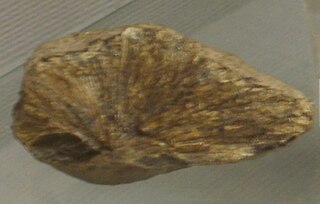
Satterlyite is a hydroxyl bearing iron phosphate mineral. The mineral can be found in phosphatic shales and was first discovered in the Big Fish River area in Yukon Territory, Canada.

Cornwallite is an uncommon copper arsenate mineral with formula Cu5(AsO4)2(OH)4. It forms a series with the phosphate pseudomalachite and is a dimorph of the triclinic cornubite. It is a green monoclinic mineral which forms as radial to fibrous encrustations.

Carminite (PbFe3+2(AsO4)2(OH)2) is an anhydrous arsenate mineral containing hydroxyl. It is a rare secondary mineral that is structurally related to palermoite (Li2SrAl4(PO4)4(OH)4). Sewardite (CaFe3+2(AsO4)2(OH)2) is an analogue of carminite, with calcium in sewardite in place of the lead in carminite. Mawbyite is a dimorph (same formula, different structure) of carminite; mawbyite is monoclinic and carminite is orthorhombic. It has a molar mass of 639.87 g. It was discovered in 1850 and named for the characteristic carmine colour.
Falsterite is a rare phosphate mineral with the formula Ca2MgMn2+2(Fe2+0.5Fe3+0.5)4Zn4(PO4)8(OH)4(H2O)14. It is a pegmatitic mineral, related to the currently approved mineral ferraioloite.
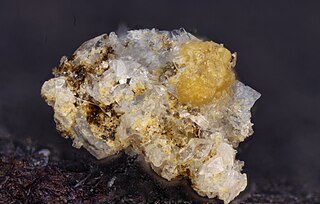
Zigrasite is a phosphate mineral with the chemical formula of MgZr(PO4)2(H2O)4. Zigrasite was discovered and is only known to occur in the Dunton Quarry at Oxford County, Maine. Zigrasite was specifically found in the giant 1972 gem tourmaline-bearing pocket at the Dunton Quarry. Zigrasite is named after James Zigras who originally discovered and brought the mineral to attention.
Lemanskiite is a mineral that was first discovered in a mine at Abundancia mine, El Guanaco mining district, Chile, with the ideal formula of NaCaCu5(AsO4)4Cl•3H2O. Originally, this mineral was discovered as being dimorphus with lavendulan, but in 2018 it was revised to only have 3 water molecules. Lemanskiite typically occurs as rosette-shaped aggregates of thin lamellar or needle-shaped aggregates, such as lammerite. Lemanskiite is dark sky blue with a light blue streak, it is brittle with an excellent cleavage plane. It was found on a dumping site in the abandoned Abundancia mine, El Guanaco mining district, Region II, Antofagasta Province, Chile The new mineral has been named after Chester S. Lemanski, Jr. This mineral and name were then approved by the Commission on New Minerals and Mineral Names of the International Mineralogical Association.

Serrabrancaite is a mineral with the chemical formula MnPO4•H2O and which is named for the locality where it was found, the Alto Serra Branca Pegmatite. The Alto Serra Branca mine has been in operation since the 1940s. It is located in Paraiba, Brazil near a village named Pedra Lavrada. Tantalite is the main mineral mined here. Specimens of serrabrancaite are kept in the Mineralogical Collections of both the Bergakademie Freiberg, Germany and the Martin-Luther Universität Halle, Institut für Geologische Wissenschaften.
Rockbridgeite is an anhydrous phosphate mineral in the "Rockbridgeite" supergroup with the chemical formula Fe2+Fe3+4(PO4)3(OH)5. It was discovered at the since-shut-down Midvale Mine in Rockbridge County, Virginia, United States. The researcher who first identified it, Clifford Frondel, named it in 1949 for its region of discovery, Rockbridge County.

















